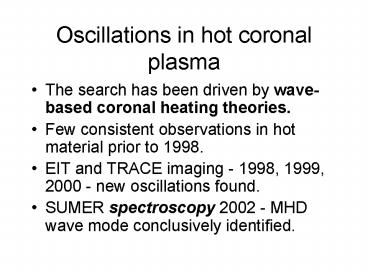Oscillations in hot coronal plasma - PowerPoint PPT Presentation
1 / 5
Title:
Oscillations in hot coronal plasma
Description:
... search has been driven by wave-based coronal heating theories. Few consistent observations in hot material ... EIT and TRACE imaging - 1998, 1999, 2000 - new ... – PowerPoint PPT presentation
Number of Views:53
Avg rating:3.0/5.0
Title: Oscillations in hot coronal plasma
1
Oscillations in hot coronal plasma
- The search has been driven by wave-based coronal
heating theories. - Few consistent observations in hot material prior
to 1998. - EIT and TRACE imaging - 1998, 1999, 2000 - new
oscillations found. - SUMER spectroscopy 2002 - MHD wave mode
conclusively identified.
2
Other methods (1)
- Lomb-Scargle periodogram (Lomb 1976 Scargle
1982) - good for unevenly sampled data. Well
understood confidence level properties. Large
literature of application and theory. - Empirical mode decomposition (EMD Huang et al
1998, 1999). The method gives a decomposition of
the signal into essentially band-limited
components by using information from the signal
itself instead of prescribing basis functions
with fixed frequency, such as in Fourier
analysis, or imposing a particular set of basis
functions, as is the case with wavelet analysis.
Handles nonstationary data, good for filtering -
but many empirical aspects. See Terradas et al.
(2004)
3
Other Methods (2)
- Multi-fractals - used to look at bursty type
behaviour in time series looking for evidence of
statistical processes (for example, financial
time series, heart rhythms, or solar flares -
MacAteer et al, in preparation). Active area of
research in many disciplines, but problems in
implementation and interpretation. - Complex empirical orthogonal eigenfunctions.
Observed oscillations occur in space and time -
the signal is decomposed into spatial components
(eigenfunctions) that have a time varying
amplitude. The eigenvalues describe how strong
each component is. See Terradas et al. (2004).
Noise properties not well understood - unless you
know better!
4
Randomization test (Linnell Nemec and Nemec 1985)
- Originally developed to test significance of
periods detected in variable star light curves - Null hypothesis no periodicity
- Alternative hypothesis the light curve contains
a periodic function with a given period P. - Also tests hypotheses that the period is equal to
a specified value, or not. - Be careful with light curves containing multiple
periodicities.
5
Many, many other methods exist - for example.
- The correct period of the time series orders the
data in the best possible way - this leads to the
information (Shannon) entropy approach to
identifying periods - (Cincotta et al., 1995,
ApJ) - Expand time series into orthogonal polynomials
(better for non-sinusoidal signals
Schwarzenberg-Czerny 1996) - Phase Dispersion Minimization (Stellingwerf 1976)
- Fractal dimension (Watari 1996)
- Singular spectrum analysis (Watari 1996) -
separates periodic, chaotic, and random
components.































